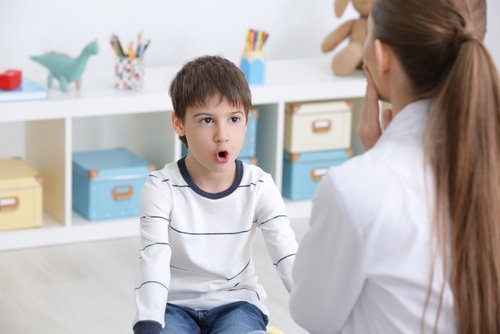Who to Do If Your Child Can't Pronounce The Letters R and S

Should I be worried if my child can’t pronounce the R and S sounds?
It’s important to know there’s no specific time limit in which children learn to pronounce certain letters or words.
In fact, this difficulty has become so common that specialists have given it a name, dyslalia.
Dyslalia refers to difficulties in pronouncing certain sounds – consonants and/or vowels – due to structural defects in the organs involved in speech.
Furthermore, these sounds can be confused in speech due to their incorrect articulation.
This type of speech difficulty has a variety of possible causes, such as the following:
- Lack of maturation of speech organs due to excessive chewing of bottles or pacifiers.
- The result of being tongue-tied, illnesses related to hearing loss, malformation of the speech organs, respiratory problems.
- Developmental delays.
- Bilingualism.
- Difficulty with fine motor control.
- Difficulty with the perception and acquisition of movements.

Is it possible to prevent dyslalia in children?
Unfortunately, dyslalia is generally the result of external problems that are often out of parents’ hands.
However, there are several ways to prevent dyslalia. For example:
- Teach your child to breathe through her nose and to blow her nose.
- Give your little one solid foods that require her to make an effort to chew.
- Check your child’s ear canals and hearing often.
- Play with sound recognition with bells and instruments.
- Exercise your child’s speech organs, with onomatopoeia and making faces.
People who are in constant contact with a child can use these methods of preventing dyslalia, as can teachers, cousins, siblings, etc.
These techniques will not only allow you to notice any alteration in your little one’s pronunciation, but they’ll also allow you to act upon any issue as soon as possible.
How to improve a child’s pronunciation of the letters R and S?
There are diverse enunciation and articulation techniques that can improve difficulties with pronouncing the R and S sounds:
Deep breathing
Before beginning to speak, enunciate and articulate, children must prepare their vocal tract with deep breathing exercises.
These exercises will also help children gain a greater awareness of their facial muscles and allow them to relax.
Another advantage to these exercises is that they give the child the possibility to focus completely on his tongue.
This makes it easier for him to move his tongue in the correct way to obtain correct pronunciation of words and sounds.
“There are diverse enunciation and articulation techniques that can improve difficulties with pronouncing the R and S sounds”
Give a good example
If a child doesn’t pronounce the R and S sounds correctly, it’s often because she hasn’t noticed the difference in their articulation. Nor has she learned how to generate the sounds in the correct way.
However, you can help to reduce this problem considerably by demonstrating to your child how to do so.
You may need to exaggerate the articulation and sound of these letters so that your child can better perceive them.
Tongue exercises
The tongue is a muscle. And just like any other muscle in the human body, it requires care and training to function adequately.
There are numerous exercises you can do to facilitate the tongue’s movement. Here are some examples:
- Moving the tongue while chewing on food.
- Touching each tooth with the tip of the tongue.
- Stretching or folding the tongue quickly.
- Sticking out the tongue and pulling it back in.

Take advantage of available materials
These days, there are plenty of interactive materials for little ones. You can find books, videos and applications that can help your child learn to speak and pronounce correctly.
If you use these tools appropriately, you won’t only improve your child’s speech, but your child will also have fun in the process.
Remember, the aspect of fun makes any learning process easier! So, what are you waiting for?
Should I be worried if my child can’t pronounce the R and S sounds?
It’s important to know there’s no specific time limit in which children learn to pronounce certain letters or words.
In fact, this difficulty has become so common that specialists have given it a name, dyslalia.
Dyslalia refers to difficulties in pronouncing certain sounds – consonants and/or vowels – due to structural defects in the organs involved in speech.
Furthermore, these sounds can be confused in speech due to their incorrect articulation.
This type of speech difficulty has a variety of possible causes, such as the following:
- Lack of maturation of speech organs due to excessive chewing of bottles or pacifiers.
- The result of being tongue-tied, illnesses related to hearing loss, malformation of the speech organs, respiratory problems.
- Developmental delays.
- Bilingualism.
- Difficulty with fine motor control.
- Difficulty with the perception and acquisition of movements.

Is it possible to prevent dyslalia in children?
Unfortunately, dyslalia is generally the result of external problems that are often out of parents’ hands.
However, there are several ways to prevent dyslalia. For example:
- Teach your child to breathe through her nose and to blow her nose.
- Give your little one solid foods that require her to make an effort to chew.
- Check your child’s ear canals and hearing often.
- Play with sound recognition with bells and instruments.
- Exercise your child’s speech organs, with onomatopoeia and making faces.
People who are in constant contact with a child can use these methods of preventing dyslalia, as can teachers, cousins, siblings, etc.
These techniques will not only allow you to notice any alteration in your little one’s pronunciation, but they’ll also allow you to act upon any issue as soon as possible.
How to improve a child’s pronunciation of the letters R and S?
There are diverse enunciation and articulation techniques that can improve difficulties with pronouncing the R and S sounds:
Deep breathing
Before beginning to speak, enunciate and articulate, children must prepare their vocal tract with deep breathing exercises.
These exercises will also help children gain a greater awareness of their facial muscles and allow them to relax.
Another advantage to these exercises is that they give the child the possibility to focus completely on his tongue.
This makes it easier for him to move his tongue in the correct way to obtain correct pronunciation of words and sounds.
“There are diverse enunciation and articulation techniques that can improve difficulties with pronouncing the R and S sounds”
Give a good example
If a child doesn’t pronounce the R and S sounds correctly, it’s often because she hasn’t noticed the difference in their articulation. Nor has she learned how to generate the sounds in the correct way.
However, you can help to reduce this problem considerably by demonstrating to your child how to do so.
You may need to exaggerate the articulation and sound of these letters so that your child can better perceive them.
Tongue exercises
The tongue is a muscle. And just like any other muscle in the human body, it requires care and training to function adequately.
There are numerous exercises you can do to facilitate the tongue’s movement. Here are some examples:
- Moving the tongue while chewing on food.
- Touching each tooth with the tip of the tongue.
- Stretching or folding the tongue quickly.
- Sticking out the tongue and pulling it back in.

Take advantage of available materials
These days, there are plenty of interactive materials for little ones. You can find books, videos and applications that can help your child learn to speak and pronounce correctly.
If you use these tools appropriately, you won’t only improve your child’s speech, but your child will also have fun in the process.
Remember, the aspect of fun makes any learning process easier! So, what are you waiting for?
All cited sources were thoroughly reviewed by our team to ensure their quality, reliability, currency, and validity. The bibliography of this article was considered reliable and of academic or scientific accuracy.
- Cab, A., Campechano, E., Flores, Y. G., López, C. A., Zamora, R. O., Reyes, A. & Vallard, E. (2012). Dyslalia associated with oral habits. Oral, 13(41), 865-869.
- Guerra-Manso, E. L., Márquez-Valdés, A. M., & Domínguez-Hernández, E. (2018). La orientación familiar en apoyo a la labor logopédica para la corrección del rotacismo. Márgenes, 6(3), 62-74.
This text is provided for informational purposes only and does not replace consultation with a professional. If in doubt, consult your specialist.








